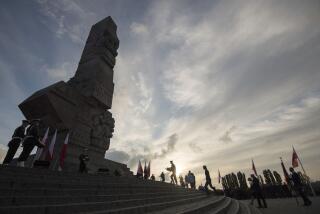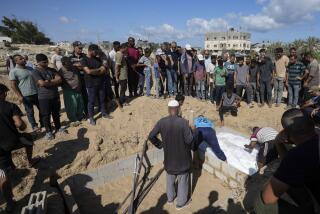Bosnian Vandals Shatter Peace at Jewish Cemetery
SARAJEVO, Bosnia-Herzegovina — Aleksandru Moise’s 64 years ended July 14, 1945, just three months after partisan guerrillas liberated this city from the Nazis. He was buried beneath a black marble tombstone in a Jewish cemetery nearly four centuries old.
On Nov. 10, at least five Bosnian Muslim teenagers allegedly toppled his grave marker, along with about 30 others in the cemetery, shocking a city that is struggling to regain its honor as a symbol of ethnic and racial harmony.
Police arrested five boys, ages 13 to 15, who have not been named because they are juveniles. The Muslim teens insist that they acted alone and were only having fun. But Bosnia-Herzegovina’s leading intellectuals are among many here who suspect a more sinister motive.
“The unofficial story told by the [cemetery’s] neighbors was that they saw eight adults and they started overturning the gravestones,” Jakob Finci, a Bosnian Jewish community leader and human rights activist, said in an interview here.
“When the first was overturned, it was like an earthquake. Some of them were really very heavy. Neighbors called the police, who arrived, and these guys fled. After one hour, they came back to finish the job because they were paid, not just to overturn one or two tombstones.”
Heavy logs, apparently from a birch tree chopped down nearby, lay near damaged tombstones and may have been used as battering rams.
Moise survived the Holocaust by three months, and his grave made it through Bosnia’s 1992-95 war unscathed, only to be toppled by vandals. The heavy marble tombstone fell in one piece, and even his image, embossed on white ceramic, remained intact. But someone chipped away at Moise’s face until it was gone, as if trying to kill any memory of him.
Circle 99, Bosnia’s largely Muslim association of independent writers, historians and other intellectuals, called the attack a “neo-Nazi and anti-Semitic outburst of hatred and intolerance.”
The vandals, who knocked down some tombstones weighing more than a ton, were more focused “on the [multiethnic] foundations of the state of Bosnia” than on the country’s small Jewish community, which numbers about 700, the group added in its statement this week.
Blaming only the teens, the group said, “is a very cynical attempt to avoid holding responsible those who are truly guilty, those who inspire hate and violence.”
Sarajevo, the capital, is one of the few places in Bosnia that has managed to at least partly repair a multiethnic fabric shredded by the war. The city calls itself “the Jerusalem of Europe” because of its religious diversity.
So the ransacking of a Jewish cemetery founded about 370 years ago created a furor that was still playing out in local media almost two weeks later.
Several local officials apologized for the damage and promised an estimated $30,000 to repair the graves. The U.S. Congress already is paying $100,000, matched by the local government, to fix the cemetery’s chapel, which was badly scarred by the Bosnian war.
But Bosnia’s federal government has been silent, said Finci, who believes that Muslim extremists sponsored the attack to stir up nationalist passions on the eve of the nation’s Nov. 11 elections.
Under the headline “Children Are the Strongest Army,” editor Senad Avdic of the magazine Slobodna Bosna asked “if somebody older, more serious, more sleazy, destructive and bloodthirsty, quietly whispered to them, suggesting what they should do.”
Sarajevo prosecutor Rasim Radovovic said he could not comment on the allegations because the accused are juveniles. But he confirmed that the teens may be charged with defiling a grave, which carries a maximum penalty of a year in jail.
The cemetery was vandalized on the 62nd anniversary of Kristallnacht, the “Night of Broken Glass,” when Nazis led murderous riots against Jewish shops and synagogues in Germany and Austria. They began a pogrom that would claim 6 million Jewish lives during World War II.
But Finci doubts that Bosnian children would have known the date’s significance, and he dismissed a theory that the teens were taking revenge for the deaths of Palestinians in clashes with Israelis.
During four years of occupation in World War II, the Nazis didn’t damage the Jewish cemetery. But many of the gravestones and tombs were pockmarked by bullets and shrapnel during the Bosnian war.
Slavko Aleksic, a notorious Serbian paramilitary commander, used the cemetery during the Bosnian war as a base from which he terrorized civilians with sniper and mortar fire.
More to Read
Sign up for Essential California
The most important California stories and recommendations in your inbox every morning.
You may occasionally receive promotional content from the Los Angeles Times.










